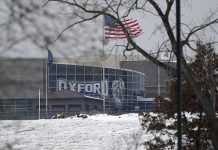Those who think folk music is just aging hippies quietly strumming old protest songs are sorely mistaken. And when it comes to the thriving folk scene in Michigan and beyond, Ann Arbor’s The Ark is as vital as ever, hosting everyone from up-and-coming acts to old favorites who return year after year.
“We struggle with being tagged as a ‘folk’ organization [and there’s a] stigma that can go with that,” says The Ark’s Executive Director Marianne James. “We’re reclaiming that word for our purposes.”
To celebrate their first half century, they came up with a slogan: “50 Folkin’ Years.”
“The tag line is a way to kind of wink at people and [also] get them to think about folk a little bit differently,” she says. “We take our mission seriously, but we also have fun and connect with people and artists.”
The Ark has become one of the country’s top music clubs, hosting “big names before they were big names,” says James. Consider this short list: Joan Baez, Lyle Lovett, Arlo Guthrie, and Townes Van Zandt. Or more recently, acts like Ani DiFranco and The Avett Brothers.
What does folk music sound like today? An enormously broad spectrum of acts and styles perform some 300 nights each year in The Ark’s intimate 400-seat room. But it used to be even more intimate.

Building The Ark
The original Ark (pictured above) was in an old Victorian house on Ann Arbor’s Hill Street.
When Charlie Roehrig came to the University of Michigan in 1967 to attend grad school, “folk music was really in, it was the place,” he says. Now the longtime guitarist/singer of the RFD Boys — known as the “house band” of Michigan bluegrass — is also The Ark’s treasurer.
The original Ark hosted acts like Grammy award winner Doc Watson and his son Merle. “To see them sitting in a living room in a couple of chairs” was the ultimate setting, Roehrig says.
Music wasn’t The Ark’s original focus. In 1965, four local churches got together to form Hill House — a safe place for students to gather in the turbulent 1960s. It became a creative outlet for music, poetry, and artwork, and soon earned the name The Ark (as in seeking shelter from a storm).
And it has been “afloat” ever since. But it hasn’t always been smooth sailing.

Making Friends, Raising Funds
After financial support from the churches dried up, The Ark started to charge admission and ask for donations. It became a 501(c)(3) nonprofit organization, and in 1977, began a fundraiser now known as the annual Ann Arbor Folk Festival. The event provides a large chunk of The Ark’s operating funds.
Donations are also key, accounting for some $250,000 a year in levels that range from an “introductory” $5 membership (it allows patrons the ability to buy alcohol for themselves and their guests at The Ark) to $5,000. There’s also corporate support from funders such as Ford Motor Co. and DTE Energy.
In the early 1980s, First Presbyterian Church took Hill House back. The Ark moved to its “middle” location above South Main Market in 1984. It continued to thrive, and “Ark III” opened at its current location at 316 S. Main St. in September 1996.
Members and volunteers have helped keep The Ark above water. A capital campaign helped turn a department store into today’s world-class venue.
Even after the recession of 2008, right after longtime program director Dave Siglin retired, strong ticket sales and membership retention helped The Ark weather the storm. “People are very passionate about The Ark,” James says. “We still have artists [and] volunteers that were here at the beginning or close to the beginning.”
Roehrig agrees. “It’s been a huge part of our lives,” he says, adding that like many fans, he’s brought his kids and now grandkids to shows.
Throughout most of its history, The Ark never owned its own space. “That was a huge vulnerability,” James says. “As we approached the 50th, someone on the board said it’s great to be celebrating the past, but what about the next 50 years?”
So the organization got busy, and in late December 2012, purchased their current venue.
Now they’re getting ready to party. They’re holding “reunions” in August, then a big fling for their annual fall fundraiser on Sept. 27.
National act Steel Wheels will be on hand, with the RFD Boys warming them up.
Launching New Careers
The Ark has long been a launching pad for emerging artists. Roehrig recalls that Grammy winner Alison Krauss was a warm-up act for the RFD Boys before she rocketed to genre-crossing fame.
A band like The Accidentals is another example of The Ark reaching new audiences. Far from aging hippies, Traverse City-based multi-instrumentalists Katie Larson and Savannah Buist (touring with Michael Dause), aren’t even 21 yet. They played their first headline gig at The Ark this June to a packed crowd of “more mature” regulars peppered with high-school-age fans.
“The Ark was always the venue to see a really cool show,” says Dause, who grew up in Northville.
Artists and fan of the folk scene in Traverse City is well aware of The Ark. “We’d post on our Facebook page: ‘Where would you like to see us?’ ” Buist says. “And overwhelmingly it was The Ark.”
To break in at The Ark, they befriended popular Ann Arbor-area singer/songwriter Abigail Stauffer and asked if they could open one of her shows.
“She agreed to have us play at The Ark with her way back when,” for her record release, says Buist.
Stauffer jokes that “way back when” to the twenty-somethings means last August. But she’s impressed with how they’ve grown “in terms of their music career and how far they’ve come” since then.
They certainly have. After playing the South By Southwest festival in Austin, Billboard magazine’s staff named them one of seven “breakout” acts.
They’re gaining fans in ways big and small — from getting a production deal with metro Detroit native Marshall Crenshaw to having someone send gas money to help them get around on tour. He also bid on “we will write you a song” on their “IndiGoGo garage sale.” They dedicated the song called “Michigan” to him during The Ark show.
“Michigan and Michigan artists are so collaborative and supportive,” Larson says.
Need proof? The Accidentals got a lot of help for their first time headlining The Ark. Stauffer agreed to be the opening act. Local favorites and national act Appleseed Collective showed up to help as well, even on a rare day home from a grueling tour schedule. Hip hop/motivational blues artist Rick Chyme from Grand Rapids also joined them on stage. (Folk mixed with rap — someone called it “Frap” — is certainly not your grandfather’s folk show.)
“Not all places are as supportive outside of Michigan,” says Buist, adding: “You can always tell when you’re back.”
There’s a lot of truth to that, says Appleseed Collective guitarist Andrew Brown. “We just try to find all The Arks around the world.”
Judging from the crowd’s reaction, The Accidentals will likely return. Like the line in the “Michigan” song they debuted here, they may join the list of artists who come back to The Ark “again and again and again and again.”
Visit the ark.org for information about events and shows. The Accidentals are playing the Fair Lane Folk Festival on Aug. 1. Visit fairlanefolkfest.org.
|
|
|










